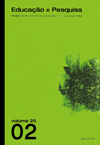Autonomia e formação humana em situações pedagógicas: um difícil percurso
DOI:
https://doi.org/10.1590/S1517-97021999000200005Palabras clave:
Educação democrática, Autonomia, Pedagogia humanista, Natureza humanaResumen
Este artigo desenvolve uma discussão sobre o processo de estruturação da autonomia da criança em situações pedagógicas. Inicia buscando fazer a distinção entre os conceitos de liberdade e autonomia, posto que freqüentemente tomados como sinônimos. Estabelecer esta distinção é fundamental para explicitar o caráter não inato da autonomia, qualidade do ser que precisa de estruturação. Na abordagem teórica escolhida para esta discussão, de caráter interacionista, a estruturação da autonomia é encarada como um processo que precisa ser construído, entre a liberdade natural, inerente à natureza humana, e a capacidade da criança se auto-regular, na relação com as necessidades de seus semelhantes. Este processo é considerado aqui como resultante de um diálogo entre as potencialidades inatas da criança e os elementos externos ao seu eu: a cultura e as relações sociais. Quando esta interação não é coercitiva e nem permissiva, dar-se-iam as condições necessárias para a estruturação saudável do eu, isto é, o processo de formação humana, entendida no sentido mais rigoroso e pleno de positividade. A reflexão desenvolvida é fundamentada na pedagogia humanista, especialmente no pensamento de Rousseau, Rogers e Dewey. O texto conclui com uma visão positiva sobre as possibilidades de construção da autonomia, mas tenta mostrar, dentro dos seus limites e do seu horizonte teórico, que esta é uma possibilidade problemática. Isto se daria pela dificuldade do agir e do compreender democráticos em uma sociedade simultaneamente diretiva e permissiva.Descargas
Los datos de descarga aún no están disponibles.
Descargas
Publicado
1999-07-01
Número
Sección
Artículos
Licencia
Los conceptos emitidos en los artículos son de exclusiva responsabilidad de sus autores y no reflejan necesariamente la opinión de la redacción.
Está permitida la reproducción total o parcial de los trabajos, siempre y cuando se indique explícitamente la fuente.
Cómo citar
Autonomia e formação humana em situações pedagógicas: um difícil percurso . (1999). Educação E Pesquisa, 25(2), 57-68. https://doi.org/10.1590/S1517-97021999000200005



